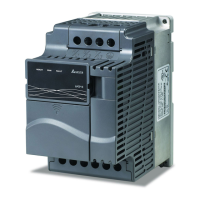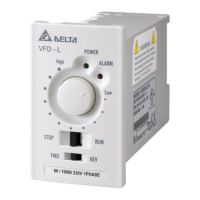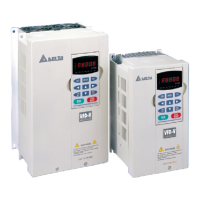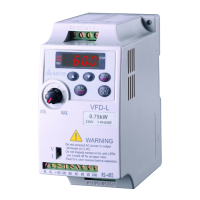Do you have a question about the Delta VFD7A5MS23ANSHA and is the answer not in the manual?
Details on the drive's nameplate, including model, input/output voltage, firmware version, and certifications.
Explains the model naming convention for the Delta MS300 series drives, detailing each part of the code.
Explains the structure and location of the serial number on the drive, crucial for identification and warranty.
Describes the RFI jumper's function for surge protection and EMC filter performance, and how to remove it.
Provides detailed dimensions (W, H, D, W1, H1, D1, S1) for Frame B models.
Provides detailed dimensions (W, H, D, W1, H1, D1, S1) for Frame C models.
Provides detailed dimensions (W, H, D, W1, H1, D1, S1) for Frame D models.
Provides detailed dimensions (W, H, D, W1, H1, D1, S1) for Frame E models.
Provides detailed dimensions (W, H, D, W1, H1, D1, S1) for Frame F models.
Details the dimensions (W, W1, W2, W3, H, H1, H2, H3, D, D1, D2, D3, D4, S1) of the KPMS-LE01 digital keypad.
Specifies required clearances (A, B, C) and installation conditions for single drive, side-by-side, and zero stack configurations.
Provides wiring diagrams for single-phase and three-phase power connections, including optional components like DC choke and brake resistor.
Illustrates the system wiring diagram, detailing connections for power input, contactors, reactors, filters, and motor.
Shows the main circuit diagram for 1-phase and 3-phase power, detailing terminals for input, output, DC reactor, brake resistor, and earth connection.
Details specifications for ring lugs, including dimensions, AWG, Kit P/N, and torque values for different frames.
Explains analog input terminal requirements, including shielded wiring, twisted pair, and noise reduction techniques.
Details contact input terminals for Sink and Source modes, including power supply requirements and connection configurations.
Describes transistor output terminals, emphasizing correct polarity and surge absorber connection for relays.
Lists applicable brake resistors and brake units for 230V and 460V models, including specifications like braking torque, resistor value, and part numbers.
Provides a table of non-fuse circuit breaker ratings (in A) required for different voltage and phase configurations of MS300 series drives.
Lists fuse specifications (Output A) for branch circuits, complying with NEC and Canadian Electrical Code requirements.
Provides step-by-step instructions for installing option cards, including removing the cover, aligning clips, and fastening screws.
Details features, product profile, specifications (Network Interface, Electrical, Mechanical), and communication parameters for the MODBUS TCP option card.
Lists specifications for 230V series 1-phase drives, both with and without built-in filters, covering applicable motor output, input/output ratings, frame, weight, and IP rating.
Lists specifications for 460V series 3-phase drives, both with and without built-in filters, covering applicable motor output, input/output ratings, frame, weight, and IP rating.
Details environmental conditions for operation, storage, and transportation, including temperature, humidity, air pressure, pollution level, package drop, and vibration.
Provides derating curves for ambient temperature (IP20/UL Open Type and IP40/NEMA 1) and altitude, explaining how these affect output current rating.
Shows a diagram of the KPMS-LE01 digital keypad, identifying its various keys and their functions.
Details the functions of displayed items on the keypad, such as frequency command, output frequency, output current, forward/reverse commands, and parameter display.
Provides a summary of drive parameters, including identity code, rated current, and parameter reset options, with factory settings.
Details basic parameters related to motor operation, including max/output frequency, voltage, mid-point settings, and acceleration/deceleration times.
Explains digital input and output parameters, covering 2-wire/3-wire operation, multi-function inputs (MI1-MI7), and multi-function outputs (RY1, MO1, MO2).
Details analog input and output parameters, including selection, bias, gain, filter time, and signal loss handling for AVI and ACI terminals.
Covers multi-stage speed parameters, including setting frequencies for up to 15 stages and PLC buffer settings.
Details parameters for induction motors, including full-load current, rated power, rated speed, pole number, and multi-motor selection.
Explains protection parameters like low voltage, over-voltage stall prevention, over-current stall prevention, and over-torque detection.
Details special parameters such as software brake, DC brake, voltage increasing gain, restart after fault, and fan cooling control.
Describes drive parameters like identity code and rated current, linking them to specific motor configurations.
Details parameter reset options, including no function, write protect, KWH display reset, PLC reset, CANopen index reset, keypad response, and factory settings.
Explains how to set the start-up display page, allowing user-defined choices based on Pr. 00-04 settings.
Details the content options for the multi-function display, allowing users to select output current, counter value, frequency, voltage, and more.
Describes the status and indication of POWER and LINK LEDs, along with processing methods for normal and abnormal states.
Provides a troubleshooting table for common abnormalities like POWER LED off, LINK LED off, and module not found, with suggested corrective actions.
Details the Over-current during acceleration error (ocA), its descriptions, and corrective actions like checking insulation and motor capacity.
Details the Over-current during deceleration error (ocd), its descriptions, and corrective actions like checking insulation and motor capacity.
Details the Over-current during steady state operation error (ocn), its descriptions, and corrective actions like checking insulation and motor capacity.
Provides an overview of CANopen protocol, its standardization, and supporting functions like PDO, SDO, SOP, and NMT.
Explains CANopen wiring using the MMC-COP01 adapter card and RJ45 cable, emphasizing termination resistors and connection to MS300 drives.
Details CANopen control modes (DS402 standard, Delta standard old/new definition) for speed, operation, and other functions.
Summarizes the MS300's built-in PLC functions, including the WPLSoft editing tool and basic/application commands.
Provides essential notes before using PLC functions, covering communication ports, preset formats, node settings, and program transfer considerations.
Explains the process of turning on PLC functions, including connecting to a PC and selecting PLC functions via the digital keypad.
Describes the Safe Torque Off (STO) function, its purpose for achieving safe stop, and its compliance with international safety specifications.
Provides wiring diagrams for the safe control loop, including internal circuits, terminals, and STO mode connections, with notes on jumper wire usage.
Explains how to set the reset method for STO alarms using Pr. 06-44, detailing STO Alarm Latch and STO Alarm no Latch modes.
| Model | VFD7A5MS23ANSHA |
|---|---|
| Protection Level | IP20 |
| Communication Interface | RS-485 |
| Cooling Method | Fan |
| Operating Temperature | -10°C to 50°C |
| Storage Temperature | -20°C to 60°C |
| Altitude | Up to 1000m without derating |
| Protection Features | Overcurrent, Overvoltage, Short Circuit |












